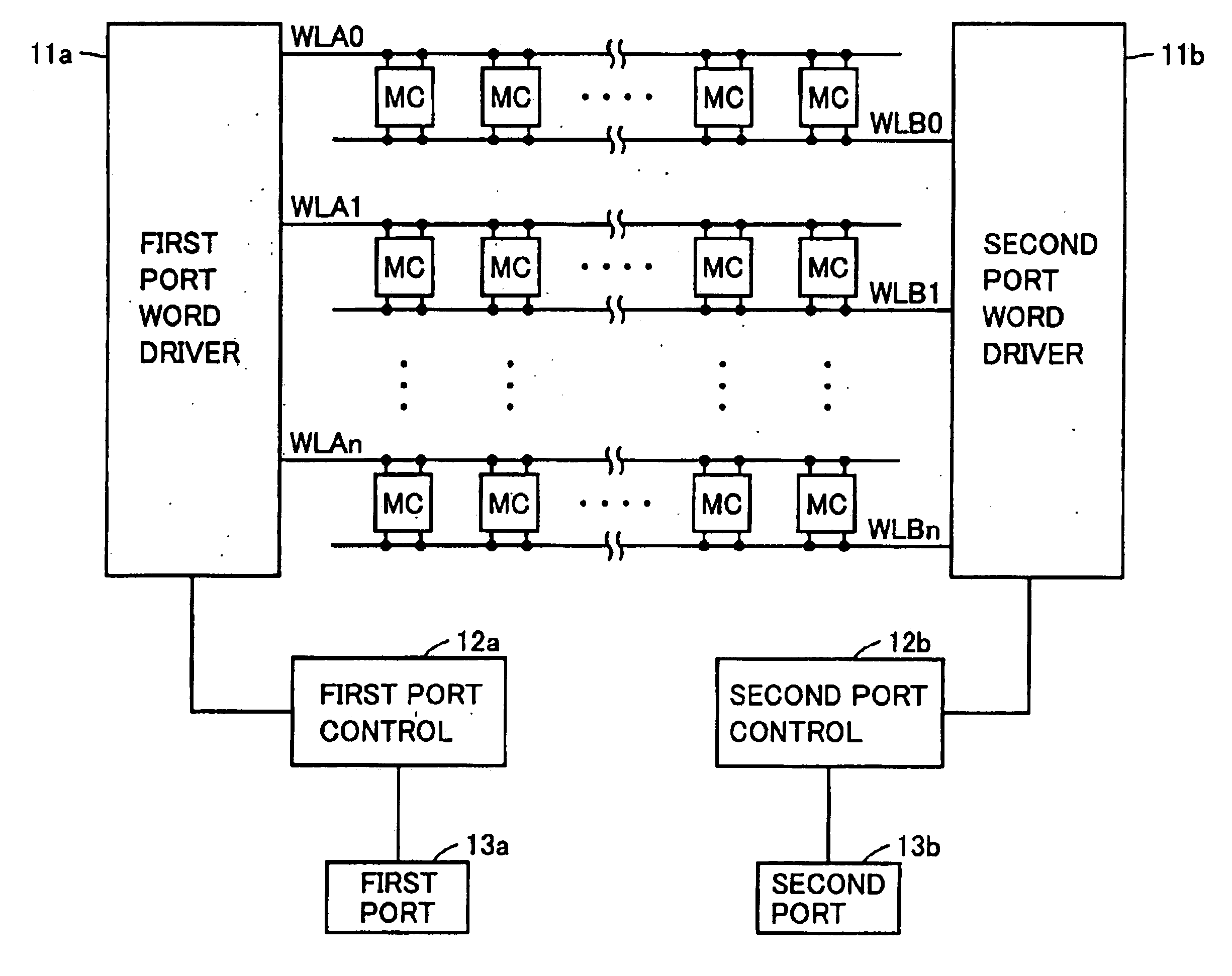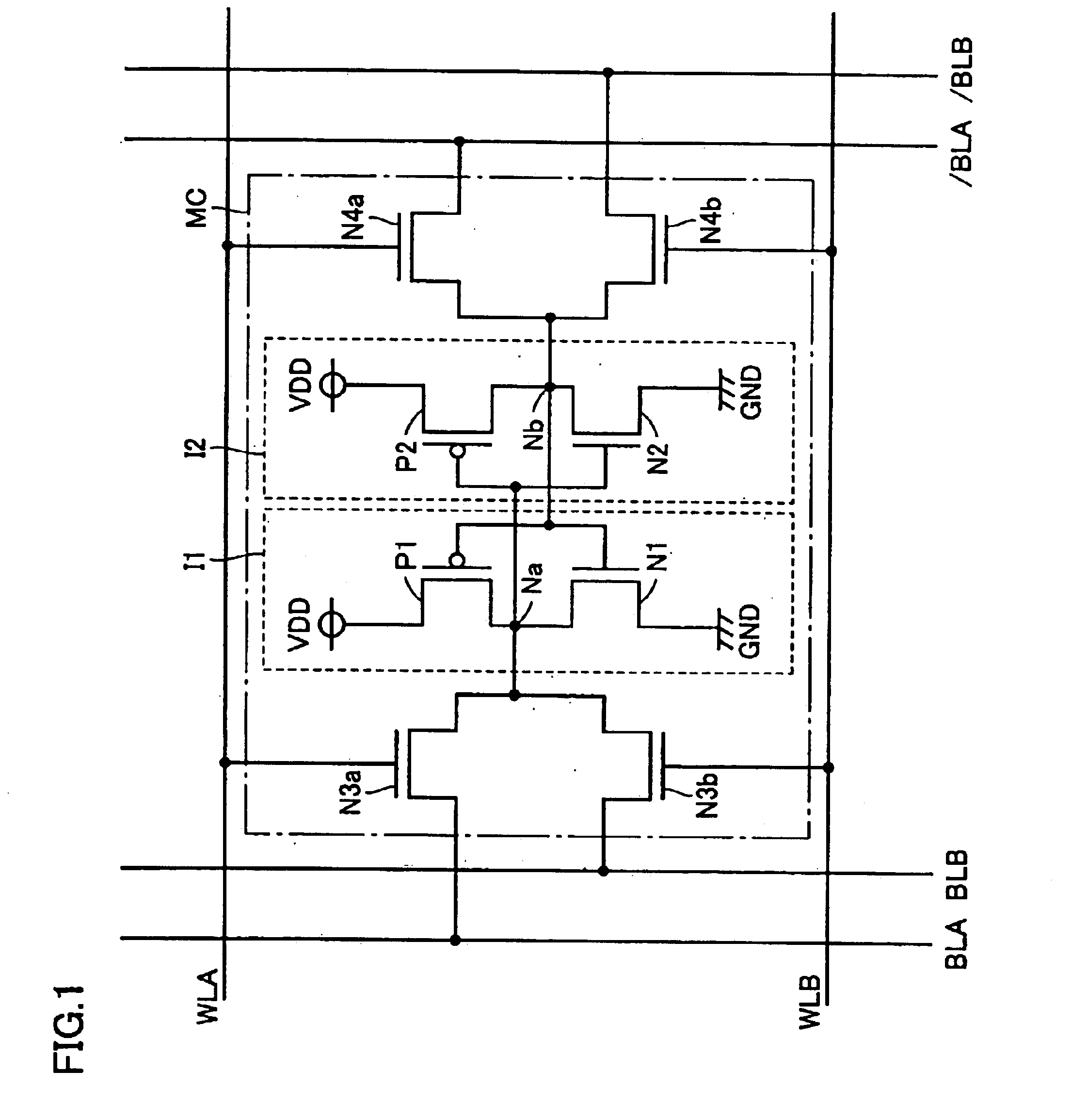Reduction of capacitive effects in a semiconductor memory device
a technology of capacitive effects and memory devices, which is applied in the direction of semiconductor devices, digital storage, instruments, etc., can solve the problems of increasing coupling noise, and achieve the effect of reducing the coupling noise between interconnections without increasing the area of memory cells
- Summary
- Abstract
- Description
- Claims
- Application Information
AI Technical Summary
Benefits of technology
Problems solved by technology
Method used
Image
Examples
first embodiment
[0040](First Embodiment)
[0041]Referring to FIG. 1, memory cell MC has two driver transistors N1, N2, two load. transistors P1, P2, and four access transistors N3a, N3b, N4a, N4b.
[0042]Each of two driver transistors N1, N2, and four access transistors N3a, N3b, N4a, N4b is formed of an NMOS transistor, and each of two load transistors P1, P2 is formed of a pMOS transistor.
[0043]NMOS transistor N1 and pMOS transistor P1 constitute a first CMOS (Complementary Metal Oxide Semiconductor) inverter I1, and nMOS transistor N2 and pMOS transistor P2 constitute a second CMOS inverter I2. A flip-flop circuit and storage nodes Na, Nb are formed by connecting the output terminal of one of first and second inverters I1 and I2 to the input terminal of the other.
[0044]The source of each of driver transistors N1, N2 is connected to a GND potential and the source of each of load transistors P1, P2 is connected to a VDD potential.
[0045]The source, gate, and drain of nMOS transistor N3a are connected ...
second embodiment
[0062](Second Embodiment)
[0063]In the present embodiment, an exemplary layout configuration to realize the word line arrangement in the first embodiment will specifically be described.
[0064]A layout configuration of memory cell MC1 of one bit will be described.
[0065]Referring mainly to FIG. 8, one n-type well region NW as well as two p-type well regions PW0, PW1 with the n-type well region NW interposed therebetween are formed on a surface of a semiconductor substrate. PMOS transistors P1, P2 are formed in n-type well NW. NMOS transistors N1, N3b, N4b are formed in p-type well PW0, and nMOS- transistors N2, N3a, N4a are formed in p-type well PW1.
[0066]PMOS transistor P1 has the source formed of a p-type diffusion region FL13, the drain formed of a p-type diffusion region FL14, and gate PL1. PMOS transistor P2 has the source formed of a p-type diffusion region FL11, the drain formed of a p-type diffusion region FL12, and gate PL2.
[0067]NMOS transistor N1 has the source formed of an n...
third embodiment
[0085](Third Embodiment)
[0086]In the present embodiment, a two-port SRAM memory cell with a read-only port, which is a different type from the first and second embodiments, will be described.
[0087]Referring to FIG. 11, this memory cell MC has two driver transistors N1, N2, two load transistors P1, P2, two access transistors N3, N4, and nMOS transistors N5, N6 constituting a read-only port.
[0088]Each of two driver transistors N1, N2, two access transistors N3, N4, and transistors N5, N6 is formed of an nMOS transistor, and each of two load transistors P1, P2 is formed of a pMOS transistor.
[0089]NMOS transistor N1 and PMOS transistor P1 constitute a first CMOS inverter I1, and NMOS transistor N2 and pMOS transistor P2 constitute a second CMOS inverter I2. A flip-flop circuit as well as storage nodes Na, Nb are formed by connecting the output terminal of one of first and second inverters I1, I2 to the input terminal of the other.
[0090]The source of each of driver transistors N1, N2 is ...
PUM
 Login to View More
Login to View More Abstract
Description
Claims
Application Information
 Login to View More
Login to View More - R&D
- Intellectual Property
- Life Sciences
- Materials
- Tech Scout
- Unparalleled Data Quality
- Higher Quality Content
- 60% Fewer Hallucinations
Browse by: Latest US Patents, China's latest patents, Technical Efficacy Thesaurus, Application Domain, Technology Topic, Popular Technical Reports.
© 2025 PatSnap. All rights reserved.Legal|Privacy policy|Modern Slavery Act Transparency Statement|Sitemap|About US| Contact US: help@patsnap.com



